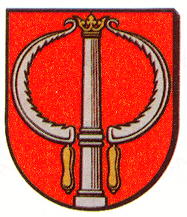Sichelnstein: Difference between revisions
Jump to navigation
Jump to search
Knorrepoes (talk | contribs) m (Text replacement - "/Arms of " to "/Arms (crest) of ") |
Knorrepoes (talk | contribs) m (Text replacement - "{{media}}" to " {{de1}} {{media1}}") |
||
| Line 22: | Line 22: | ||
The arms are canting, showing two sickles (Sicheln) and a pillar ('stein' or stone). The arms were granted by the Dukes of Braunschweig-Lüneburg in the late 18<sup>th</sup> century. The arms were also used by the Amt Münden and later by the Amt Sichelnstein (1830-1973). | The arms are canting, showing two sickles (Sicheln) and a pillar ('stein' or stone). The arms were granted by the Dukes of Braunschweig-Lüneburg in the late 18<sup>th</sup> century. The arms were also used by the Amt Münden and later by the Amt Sichelnstein (1830-1973). | ||
{{ | |||
{{de1}} | |||
{{media1}} | |||
[[Civic Heraldry Literature - Germany|'''Literature''']]: Information provided by the [http://www.staufenberg-nds.de Staufenberg_council]. | [[Civic Heraldry Literature - Germany|'''Literature''']]: Information provided by the [http://www.staufenberg-nds.de Staufenberg_council]. | ||
Revision as of 11:18, 26 December 2022
This page is part of the German heraldry portal |
Heraldry of the World |
|
German heraldry:
|
Selected collector's items from Germany:
|
SICHELNSTEIN
State : Niedersachsen
District (Kreis) : Göttingen
Incorporated into : 1973 Staufenberg
| German | |
| English | No blazon/translation known. Please click here to send your (heraldic !) blazon or translation |
Origin/meaning
The arms are canting, showing two sickles (Sicheln) and a pillar ('stein' or stone). The arms were granted by the Dukes of Braunschweig-Lüneburg in the late 18th century. The arms were also used by the Amt Münden and later by the Amt Sichelnstein (1830-1973).
Literature: Information provided by the Staufenberg_council.


